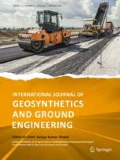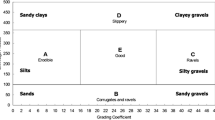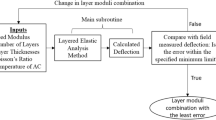Abstract
By inclusion of geosynthetics in cross-sections of pavements, either traffic capacity of pavements can be enhanced for the same structural section or structural section can be reduced for the same traffic capacity. In the past research works, two methods were mainly adopted for the analysis of reinforced pavements, one is by conducting static plate load tests over unpaved roads on the basis of subgrade bearing capacity failure and secondly by applying dynamic or cyclic loads on the paved sections and determining the traffic benefit on the basis of rutting failure criterion. In the present research study, an effort has been made to evaluate the performance of road sections reinforced with geosynthetics using AASHTO 1993 Method. The structural number (SN), which denotes the strength of the pavements, has been modified using load equivalency factor concept. The unpaved sections were reinforced in a single layer at interface and within the subgrade layer at different positions. The maximum load intensities at a settlement of 12.5 mm in unreinforced and reinforced sections were converted into Equivalent Single Axle Load at the surface of pavement using Botswana guidelines on the basis of axle load surveys (2000). Using Load equivalency factor concept, new traffic capacities were determined followed by calculation of modified SNs for reinforced sections using AASHTO 1993 Design equation. The structural contribution of geosynthetics has been quantified in the terms of Base Course Reduction (BCR) values, which is defined as the percentage reduction in structural section of base course layer for reinforced sections as compared to unreinforced section. Laboratory tests were conducted to determine the grain size distribution and other important physical parameters of soil used for preparing subgrade. It is clear from the results that there is a considerable increase in load carrying capacity of unpaved sections due to reinforcements achieving an average BCR value of about 44%, with bi-axial geogrid (BX2020) and about 30% with CE121 geonet when reinforced within top one-third of subgrade layer.








Similar content being viewed by others
References
AASHTO (1993). AASHTO guide for design of pavement structures. American Association of State Highway and Transportation Officials, Washington, D.C.
Berg RR, Christopher BR, Perkins SW (2000) Geosynthetics reinforcement of the aggregate base/sub base courses of flexible pavement structures-GMA white paper II. Geosynthetics Materials Association, Roseville, p 176
Carroll RG, Walls JC, Haas R, (1987). Granular base reinforcement of flexible pavements using geogrids. In: Proceeding of Geosynthetics’87, IFAI, New Orleans, pp. 46–57
Perkins SW, Christopher B (2012): Evaluation of AASHTO’93 layer coefficients for pavements reinforced with NAUE geogrids. Final Project Report
Perkins SW, Christopher BR, Klompmaker J (2012) Reinforced flexible pavement layer coefficients determined by mechanistic-empirical modeling. In: 5th European Geosynthetics Congress, EuroGeo5, Valencia
Al-Qadi IL, Dessouky SH, Kwon J, Tutumluer E (2008) Geogrids in flexible pavements: validated mechanisms. Journal of the Transportation Research Board, No. 2045, Transportation Research Board of the National Academies, Washington, D.C., pp. 102–109
Al-Qadi IL (2006) Pavement interlayer system mechanisms: separation reinforcement and reflective cracking control. Lecture, Chinese Soc. of Pavement Engineering, Taipei, June 2, 2006
Montanelli F, Zhao A, Rimoldi P (1997) Geosynthetics reinforced pavement system: testing & design. In: JN Paulson (ed) Geosynthetics’97 Proceedings, Long Beach, CA. vol. 2. Industrial Fabrics Association International, Roseville, MN, pp 619–632
Cancelli A, Montanelli F (1999) In-ground test for geosynthetics reinforced flexible paved roads. In: Proceedings of the conference Geosynthetics’99, Boston, MA, USA, pp 863–878
Perkins SW, Edens MQ (2003) A design model for geosynthetics-reinforced pavements. Int J Pavement Eng 4(1):37–5024
Chen Q, Abu-Farsakh MY, Tao M (2009) Laboratory evaluation of geogrid base reinforcement and corresponding instrumentation program. Geotech Test J 32(6):1–10
Giroud JP, Noiray L (1981) Geotextiles-reinforced unpaved road design. J Geotech Eng 107(9):1233–1254
Hufenus R, Rueegger R, Banjac R, Mayor O, Springman SM, Bronnimann R (2006) Full-scale field tests on geosynthetics reinforced unpaved roads on soft subgrade. Geotext Geomembr 24(1):21–37. https://doi.org/10.1016/j.geotexmem.2005.06.002
Jersey S, Tingle JS, Norwood GJ, Kwon J, Wayne MH (2012) Full scale evaluation of geogrid reinforced thin flexible pavements. Report submitted to TRB Annual meeting, Pittsburgh, PA
Anderson P, Killeavy M (1989) Geotextiles and geogrids: cost effective alternate materials for pavement design and construction. In: Proceeding of Geosynthetics’89, IFAI, vol. 2, Sand Diego, USA, pp. 353–360
Leng J (2002) Characteristics and behaviour of geogrid reinforced aggregate under cyclic load. PhD thesis, North Carolina State University, Raleigh, USA
Miura N, Sakai A, Taesiri Y (1990) Polymer grid reinforced pavement on soft clay grounds. Geotext Geomembr 9:99–123
Webster SL (1993) Geogrid reinforced base courses for flexible pavements for light aircraft: test section construction, behavior under traffic, laboratory tests, and design criteria, Technical Report GL-93-6, USAE Waterways Experiment Station, Vicksburg, MS, USA, 86 p
Kolay PK, Kumar S, Tiwari D (2014) Improvement of bearing capacity of shallow foundation on geogrid reinforced silty clay and sand. Journal of the Transportation Research Board No. 2462, Transportation Research Board of the National Academies, Washington, pp 98–108
Naeini SA, Moayed R (2009) Effect of plasticity index and reinforcement on CBR value of soft clay. Int J Civil Eng 7(2):124–130
Omar MT, Das BM, Puri VK, Yen SC (1993) Ultimate bearing capacity of shallow foundations on sand with geogrid reinforcement. Can Geotech J 30(3):545–549
Acknowledgements
This study was supported by financial grant (in the form of fellowship) to the first author, granted by the Ministry of Human Resource and Development, Govt. of India. Their support for this research work is heartily acknowledged.
Author information
Authors and Affiliations
Corresponding author
Rights and permissions
About this article
Cite this article
Singh, A.K., Mittal, S. Analysis of Reinforced Unpaved Roads by Modified Structural Number Method. Int. J. of Geosynth. and Ground Eng. 4, 1 (2018). https://doi.org/10.1007/s40891-017-0115-5
Received:
Accepted:
Published:
DOI: https://doi.org/10.1007/s40891-017-0115-5




